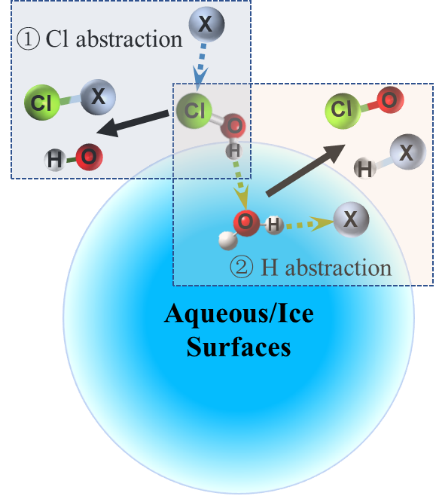近日,美国宾夕法尼亚大学钟杰博士和Joseph S. Francisco教授,与广东工业大学环境健康与污染控制研究院、环境科学与工程学院张维娜博士和安太成教授合作研究了次氯酸(HOCl)与冰和液滴界面的作用机制,研究取得了最新进展,相关成果以“Molecular Interaction and Orientation of HOCl on Aqueous and Ice Surfaces”为题发表在《Journal of the American Chemical Society》杂志上。该工作采用了第一性分子动力学模拟与量子化学计算相结合的理论方法,系统研究了HOCl在冰和液滴界面的水化行为、分布取向及其作用机制,研究结果为HOCl在大气冰晶粒表面的反应机制提供了新的认知,为深入理解HOCl引发臭氧层空洞的化学过程提供必要的理论指导。

大气中次氯酸(HOCl)源于ClONO2在极地平流层内的云滴冰面上的非均相水化反应,其光解反应或者与HCl进行的非均相反应能产生氯和氯气,进而促进臭氧分解,导致南极上空臭氧空洞的形成。实验研究表明HOCl在冰面上的非均相反应的发生十分迅速。然而这与低温条件和冰面上微弱的扩散效应相违背。因此,HOCl在冰面上的快速反应过程可能取决于其特殊的溶剂化结构。为此,本研究采用DFT梯度修正的Born−Oppenheimer molecular dynamics (BOMD) 模拟方法,探究了HOCl在冰面上和过冷液滴表面上的溶剂化结构。研究表明:HOCl易聚集在冰面和过冷液滴表面,且Cl原子总暴露在表面外,而其余的OH部分易于与界面水分子形成氢键。进一步以HOCl与Cl原子的反应过程为例,依据HOCl与界面水的结合机理,本研究提出了以下两种反应路径:1) 由于HOCl中的Cl原子与界面水作用极弱,易暴露于液滴/冰表面,因此更易作为反应活性位点从而与大气中Cl原子发生反应,形成Cl2和·OH;2) 鉴于HOCl可以作为界面水的氢键供体,故HOCl可以借助界面水将质子转移给Cl原子,从而形成HCl和ClO·。在质子转移反应的过程中,界面水起到了催化剂的作用,促使其化学能垒由11.64 kcal/mol降到6.37 kcal/mol。
Graphical Abstract

论文DOI链接:https://doi.org/10.1021/jacs.0c08994
论文英文摘要附如下:
ABSTRACT: The interaction and orientation of hypochlorous acid (HOCl) on the ice surface has been of great interest as it has important implications to ozone depletion. As HOCl interacts with the ice surface, previous classical molecular dynamics simulations suggest its OH moiety orients to the outside of the ice surface, whereas the quantum calculations performed at 0 K indicate its Cl atom is exposed. To resolve this contradiction, herein, Born−Oppenheimer molecular dynamics simulations are adopted, and the results suggest that at ambient temperature, the interaction between HOCl with interfacial water is dominated by the robust H-bond of (HOCl)H−O(H2O). As a result, the HOCl mainly acts as the proton donor to the water surface, which thus can participate in proton transfer reactions via the promotion of interfacial water. Moreover, the Cl atom of HOCl is found to be exposed to the outside of the water surface. Therefore, during the heterogeneous reactions of HOCl on the water surface, the Cl atom becomes the reactive site and is easily attacked by other species.